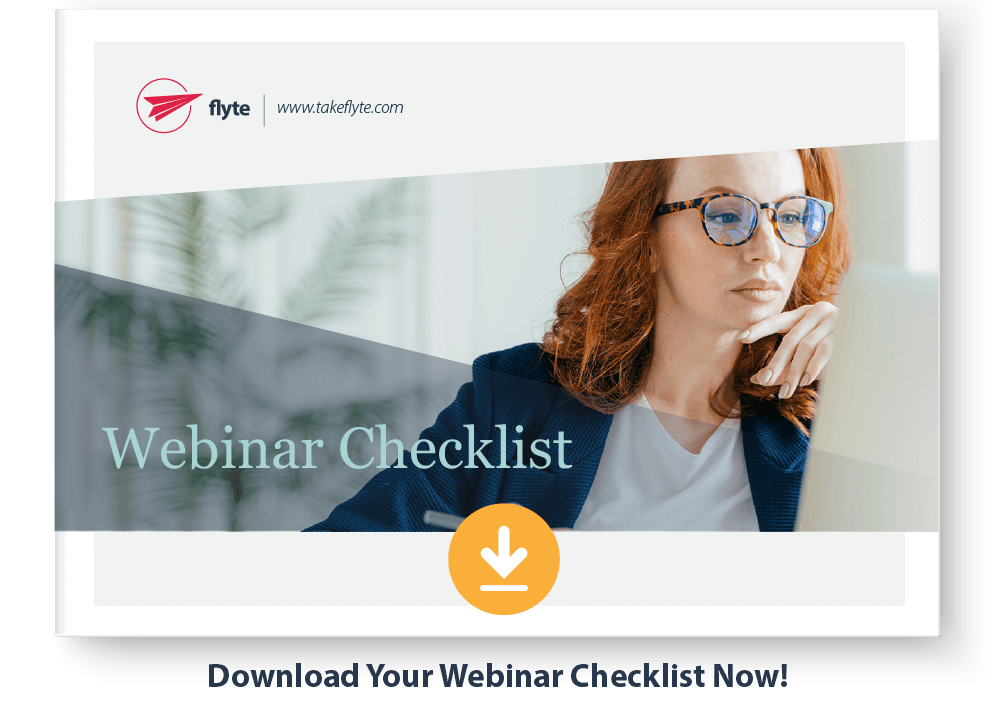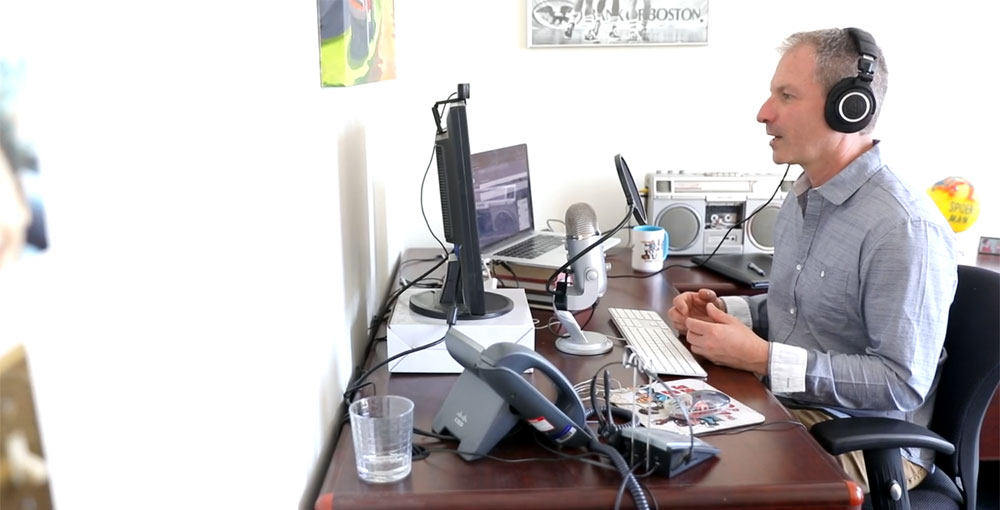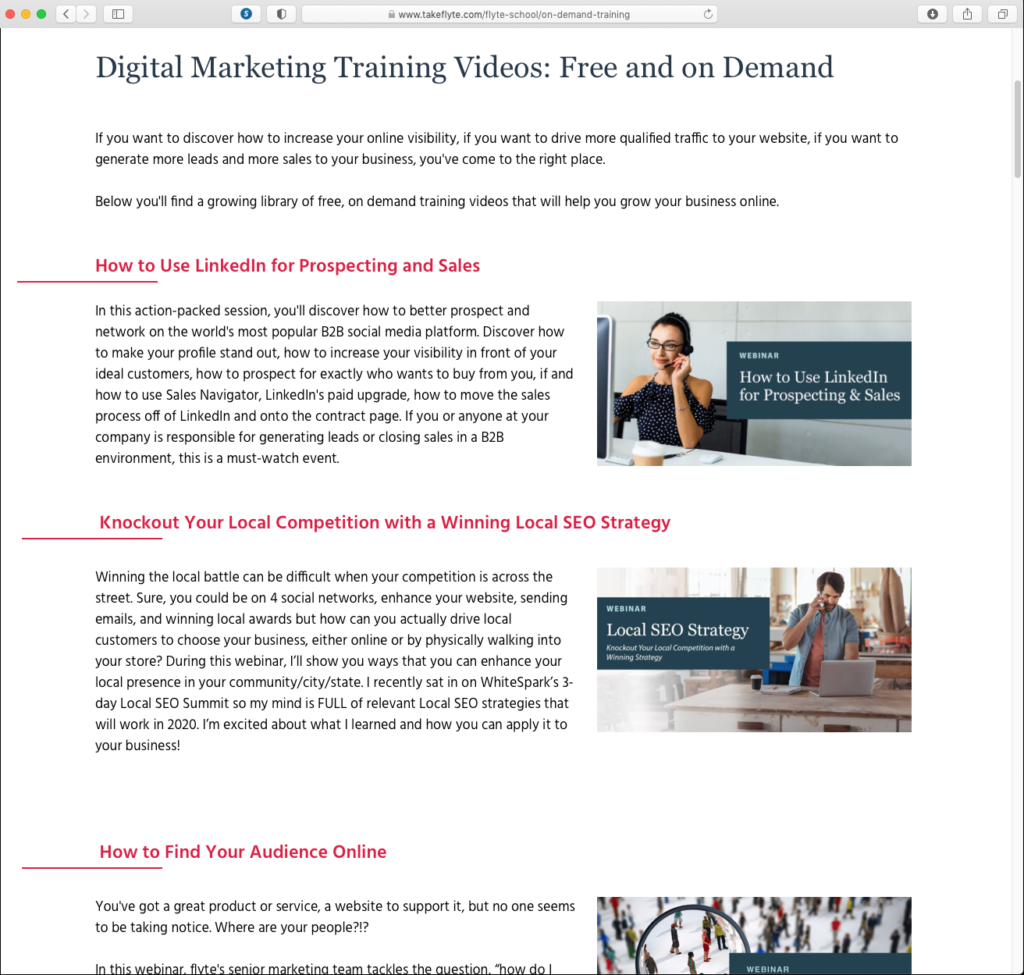 Webinars are a great, proven way to establish your expertise, build your email list, and generate more leads for your business. They can even generate revenue directly when you charge for them! Due to COVID, almost everyone interested in your products or services already has Zoom and other webinar software installed on their computer, eliminating one of the biggest barriers to entry.
Webinars are a great, proven way to establish your expertise, build your email list, and generate more leads for your business. They can even generate revenue directly when you charge for them! Due to COVID, almost everyone interested in your products or services already has Zoom and other webinar software installed on their computer, eliminating one of the biggest barriers to entry.
However, because just about everyone’s working from home and all in-person events have been cancelled, there’s a lot of webinar fatigue out there, meaning people aren’t super excited to sit through yet another online training, live stream, digital masterclass, or whatever you choose to call it.
To create a webinar that people will look forward to, pay attention to, and take action on once it’s over, apply this ten step approach to putting on a webinar that doesn’t suck!
1. Focus on your audience’s needs
As mentioned above, we are inundated with both free and paid webinars. They come at us through email, on social media, and in online ads. Companies, non-profits, entrepreneurs, Chambers of Commerce, experts, gurus, and ninjas…they all have content for us to consume in the form of two-dimensional seminars.
To succeed in this over-saturated marketplace, we really need to focus on delivering something that will make a change in our audience’s life. No one’s going to show up to your webinar unless there’s an implicit promise that it will improve their health, their wealth, or their love life.
To that end, narrow the focus and deliverables of your topic. Instead of a webinar on gardening, put on a webinar that shows people how to grow healthy, leafy greens. Instead of a webinar on email marketing, show people how to set up an autodrip campaign that shortens the sales cycle.
Alternatively, narrow your target audience. If you normally present on how businesses can set up retirement plans for their employees, focus on the specifics of how medical practices can set up Simple IRAs instead. Or even narrow it further to dentist or chiropractor offices.
When someone feels that the webinar is focused on their particular needs, they’re more likely to register and attend.
2. Research your webinar topic for keywords and new concerns
Doing some online research will help you uncover the questions that are likely to spur people to register and attend. There are a few simple and free ways to uncover the biggest problems your target audience suffers from.
Survey people on social media.
I often will pose a question on Facebook when working on a new topic. While this isn’t rigorously scientific–my question will reach only the people the Facebook algorithm shows it to, and my connections aren’t a cross-section of my entire audience–it does generate some new ideas and can take me down a fresh path.

If Facebook isn’t your jam, LinkedIn, Twitter, Reddit, or any social media platform or discussion forum are good alternatives.
Use a keyword research tool.
By plugging in some keywords that you came up with or that came up in your social media discussion, you can get a better sense of how often these searches are being performed at Google and other search engines.
Google Keyword Planner can help you with this research, or Ubersuggest is a good alternative. These tools not only suggest alternative phrases, but can also provide monthly search volume (how many people are asking about these related topics.)

Lastly, Google Trends can help uncover even more subtopics you may want to cover.
Answer the public.
One of my favorite tools for uncovering what people are interested in is Answer the Public. This free online tool pulls data from Google’s autocomplete feature for additional content ideas.

3. Create an outline that Aristotle would be proud of
Based on what you’ve uncovered, create an outline for what you want to share on your webinar. Keep in mind your audience needs: where are they now (what’s their current problem or pain point) and where do they want to end up?
As you develop your outline, keep in mind the old adage from Aristotle:
- Tell them what you’re going to tell them
- Tell them
- Tell them what you just told them
That may sound basic, or like you’re talking down to your audience, but we’re all overwhelmed with information. Setting expectations, delivering on promises, and recapping the biggest takeaways will always benefit your audience. That, in turn, will give them a more favorable reaction to your webinar, your brand, and yourself.
4. Build your slidedeck with the webinar format in mind
Once you know your content and the order you’ll deliver it, it’s time to build out your slidedeck. A few things make a webinar slidedeck different than an in-person slidedeck, in my opinion.
First, one similarity: the best slides have very few words and even fewer bullet points. The purpose of slides is not to be a substitute for the speaker. Slides that can stand on their own should be a blog post, not a presentation.
One big difference between a webinar and an in-person presentation is the connection between speaker and audience. On a webinar you can’t see your audience. Yes, some platforms may allow you to see some of your audience, assuming they have their webcam on. But chances are you’ll be focusing on your slides, and many people won’t have their webcams on or won’t be shown on screen.
Because of this, you can’t measure the level of engagement of your audience. It’s easy for someone to be “attending” your webinar while they’re also checking email or doom scrolling through social media.
To counter this, use more slides than you would in an in-person event to keep the visuals moving and stop people from looking away. Instead of one slide that lists three things new freelancers need to know about their taxes, create three unique slides that each address one of those items.
You can also work in pre-recorded videos. If you’re putting on a webinar about racial discrimination in the workplace, consider cutting away to some short videos that show examples. If your webinar is about advanced tricks in Excel, include some screen recordings of how to create and implement these powerful formulas.
The more movement and juxtaposition you can create in your webinar, the more engaged your audience will be.
5. Create moments of interactivity so people won’t drift off
 There’s an old adage, “telling isn’t selling.” It means that if you want to change someone’s outlook and get them to take action, you can’t just talk at them.
There’s an old adage, “telling isn’t selling.” It means that if you want to change someone’s outlook and get them to take action, you can’t just talk at them.
Most webinar platforms have the ability to create interactivity with your audience. You can set up polls to uncover people’s opinion or their level of expertise. You can have a chat window so people can respond in real time to the material being presented. You can open the floor to Q&A either at the end of the presentation or specific points throughout.
You can even get creative and create a “choose your own adventure” style webinar, where the audience would vote on what topic to cover next.
At live events, I like to arrive early and chat up members of the audience who are waiting…learn their names, their businesses, and where they’re from. When it comes time for me to give a specific example of how to do keyword analysis for SEO or what type of social media posts to create, I’ll use an audience’s business as an example.
This builds rapport with the audience and makes the content feel more tailored. To accomplish the same at your webinar you can promote the fact that you’re going to get on the webinar early and invite attendees to do the same. During that 10 – 15 minutes you can chat everyone up. The more the audience likes you and feels you’re there to help them, the more engaged they’ll become.
6. Practice your webinar.
You may think that this is unnecessary. After all, you don’t even have to memorize your presentation; you can just read a script off screen and no one will be the wiser.
Wrong.
You can have the most valuable content in the world, but if you deliver it like you’re reading a script, or if you’re umming and ahhing your way through the webinar, or if you’re trying to cram 60 minutes of content into a 30 minute webinar, people will zone out.
By setting aside time to practice, you will determine if you’ve got too much content, edit out weak arguments, and polish your transitions until they’re seamless.
Technical hiccups can also derail an otherwise professional webinar, so it’s a good idea to practice it as a webinar and not as an in-person presentation. You can record the practice and watch it to see if there are any problem areas…places where the content is confusing or the screen is static for too long.
If you’re going to be putting this on with someone else (and having a team will always improve your webinar), it’s a good idea to practice with them as well.
7. Promote your webinar.
No matter how good your webinar is, if no one shows up, what was the point?
At flyte, we have a procedure for promoting all of our webinars. Some of our current marketing tactics for increasing registrations and attendance include:
Creating social media-friendly graphics and videos.
We promote those through flyte’s Facebook, LinkedIn, and Twitter accounts at a minimum.

Sending out dedicated emails to our subscriber list.
By dedicated, I mean that there’s no other offer or message in the email. From the subject line to the sign-off, everything is focused on getting subscribers to register for the upcoming event. In addition, we include information about the event on our bi-weekly newsletter that’s focused on other content. This works because we continually work on email marketing and list building to ensure we can reach people who want to hear from us.
Post it to our website.
We include information both on our home page and on a dedicated Events page on our website. Best/worst of all, we promote it through a non-recurring popup window! (Cluck your tongue all you like, it works.)
Run social ads.
If we really want to boost attendance, we put some money behind our social posts and target our ideal customers by their demographics. Running our ads through Facebook Ad Manager makes this simple. This allows us to reach outside of our regular audience and get in front of similar (or lookalike) audiences who would be a good fit for this content.
8. Make your webinar engaging.
As discussed above, watching slide after slide after slide can be the digital equivalent of watching paint dry. Consider adding a little bit of spice to your presentation.

Turn on your webcam.
Most modern webinar platforms will allow you to include a webcam shot within your presentation. Just seeing your face can add some much needed dynamism to the presentation.
Make yourself look good.
If you are going to be visible during some or all of your webinar, light yourself well. Natural light is best, but not when it’s behind you! Sit facing an open window or light source so that your face is bathed with light.
Speaking of making yourself look good, there’s more that you can do. Position your webcam so that it sits at eye level. Many people use the webcam built into their laptop, which sits at an angle that’s perfect for showing the inside of their nostrils.
Ewwww, right?
If you can, it might be worth upgrading from the built-in webcam and get a free standing webcam. These take much higher-quality video and can be positioned however you need it.
Make yourself sound good.
Don’t rely on the built-in microphone from your computer. It’s far away and not good for much. The earbuds that came with your smartphone are better, but really meant for quick Zoom calls and not for a professional speaker like you!
Your budget might dictate what microphone you get, but my Blue Yeti mic does a good job and plugs directly into my laptop.

Create juxtapositions.
As mentioned above, adding video can refocus someone’s attention on the screen and away from their inbox or Facebook.
Another approach that I’ve seen recently was recording the webinar as an in-person event. The presenter stood in front of a white board and delivered her content. We got to see her whole person and the passion and excitement she brought to the topic. It was much more engaging than the typical webinar.
Even if you’re not willing to go that far, breaking away from the slides occasionally to show your whole face so that you can really engage the audience at key moments is a great way of keeping people’s engagement level high.
Leverage those moments of interactivity
As discussed before, include polls, chats, and Q&A as appropriate. Telling isn’t selling….
Don’t go on and on…
To update another old adage, the length of a webinar should be like a man’s kilt: long enough to cover the subject but short enough to keep your interest.
There’s no rule that your webinar has to go 45 minutes or an hour. Play around with webinars that are 30 or even just 15 minutes in length. No one ever complained that a webinar was too short!
9. Make your webinar a team sport.
Yes, you can certainly run a webinar by yourself. But by adding some support staff you’ll be able to focus on delivering the best possible presentation and you won’t have to worry why Mary from Albuquerque is raising her hand (virtually).
As an example, one time while I was putting on a webinar by myself I heard a knock at my office door. Because I was on a webinar and had a Do Not Disturb note on my door I ignored it. The knocking continued. I continued to ignore it.
Finally, my co-worker snuck into my office with a note that informed me that I was still showing the first slide 20 minutes into the presentation. I hadn’t noticed because it was updating on my screen.
Interesting side story: not once but twice I’ve ignored a fire alarm to finish a webinar. The second time it turned out the building was actually on fire and when the firemen came into the office they looked at me incredulously through the conference room glass. Luckily, it was a minor wiring fire and I was never in danger. Still, stupid.
In a perfect world, you’d have at least two people on hand helping you. Someone to introduce you and someone to handle any questions from the audience or manage any technical issues that come up. It can certainly be the same person, but sometimes people have different skill sets, so it’s good to put people in the right positions.
10. Follow up after the webinar is over.
Your work isn’t done after you sign off. Beyond educating your prospects and clients, you’re likely to have business objectives such as building your email list, generating leads, selling a course, and so on.
 Whatever your objective is, you should follow up with all registrants and attendees. Those aren’t the same thing. With free webinars, you can often expect only about a third of registrants to show up for the event.
Whatever your objective is, you should follow up with all registrants and attendees. Those aren’t the same thing. With free webinars, you can often expect only about a third of registrants to show up for the event.
Many webinar platforms can track whether a registrant actually attended, and allow you to follow up with each group with a customized email.
“So glad you could attend” vs. “we missed you!”
Some things you can do after your webinar is over:
- Include a link to where the webinar recording is available. For some businesses, it makes sense to make the webinar freely available to anyone. In other cases, you may wish to only make it available to registrants, or not record it at all to encourage people to show up for the webinar live and avoid FOMO.
- Repurpose the content delivered in the webinar. Your webinar video can be uploaded to YouTube. Your slidedeck can be posted to SlideShare or LinkedIn. The transcript or content can be repurposed into a blog post or podcast episode. Your best lines can be turned into Facebook posts, LinkedIn updates, tweets, or more.
- Create an upsell offer. The people who registered and attended your webinar have expressed interest in your products or services. Strike while the iron is hot! Maybe that’s a paid course, or some one-on-one consulting, or something else that makes sense for your business and your attendees.
Next Steps
 It’s a crowded, competitive world for webinars out there, but there’s still plenty of reasons why webinars should be part of your digital marketing strategy.
It’s a crowded, competitive world for webinars out there, but there’s still plenty of reasons why webinars should be part of your digital marketing strategy.
By taking these 10 steps to heart, you too can create webinars that don’t suck, building your audience, generating more leads, and growing your business.
Enter your details to download our Webinar Checklist
If you need help developing your content, promoting your webinar, or even putting it on, let us help. Just reach out to us today and we’ll help your webinar strategy take flyte.
Rich Brooks
As Seen on a Webinar
